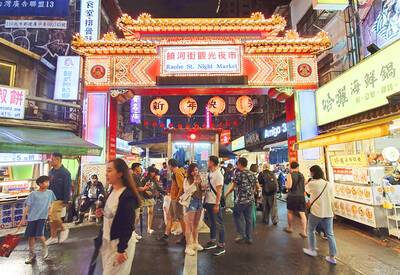As Asian-Americans across the US marked the Lunar New Year on Tuesday, they could celebrate by eating Mickey Mouse-shaped tofu, sporting a pair of Year of the Pig-inspired Nike shoes and by snacking on pricey cupcakes.
The delicacies and traditions that once made a generation of Asian-Americans feel foreign are now fodder for merchandizing. Between now and Feb. 17, Disney California Adventure Park is offering “Asian eats” that include the Mickey-shaped tofu and purple yam macarons. Nike is issuing a limited-edition Chinese New Year collection of shoes with traditional Chinese patchwork. Housewares giant Williams Sonoma has a slew of Lunar New Year dishware, and its Web site offers a set of nine “Year of the Pig” cupcakes for US$80.
Robert Passikoff, a marketing consultant and founder of Brand Keys Inc, said there has been a “reawakening” in the past few years of the US’ world view of China, but it is also about differentiating your business and growing revenue, not necessarily inclusion.

Photo: AP
“They’re not there as social workers to create harmony among the disenfranchised people,” Passikoff said. “The other side is brands are all looking for an itch, they’re all looking for some way to engage customers. And if the Lunar New Year will do it, why not?”
Chinese fast-food chain Panda Express (熊貓快餐) funded a New Year’s-themed interactive exhibit inside a Los Angeles mall. “The House of Good Fortune: A Lunar New Year,” includes different rooms showcasing customs, like a room of “flying” red envelopes and a “hall of long noodles,” a customary dish that symbolizes long life.
Crazy Rich Asians cast member Harry Shum Jr (岑勇康) promoted the exhibition and brushed off those who may scoff at the company’s efforts.

Photo: AP
“I think it’s good to be reminded of these traditions. It’s been so important for many generations before us to try and pass that on and also experience it in a new way,” Shum said.
Andrea Cherng, Panda Restaurant Group Inc’s (熊貓餐飲集團) chief marketing officer and the daughter of Chinese-American founders Andrew Cherng (程正昌) and Peggy Cherng (蔣佩琦), said she knows some Asian-Americans will roll their eyes.
“Now the reality about Panda is that we were many people’s first Chinese experience in the US,” Andrea Cherng said. “But then what a fantastic opportunity for us to be able to bridge cultures and bring to them our interpretation of what’s so special about this holiday.”
Christopher Tai, 37, of San Francisco, recently bought a Golden State Warriors jersey specially made for the Lunar New Year as a gift for his girlfriend’s father. The design includes the Chinese character for “warrior.” He said the jersey shows an effort at inclusion.
“They’re recognizing an underrepresented part of their fan base,” Tai said.
However, he wonders if shoppers who snap up Williams Sonoma dishware will come away learning anything.
“I feel like a lot of people are attracted to these aesthetic elements like say red, dragons, dogs or shiny gold, without really knowing the significance of the colors and symbols and what the animals mean,” Tai said.
Most Chinese traditionally ring in the Lunar New Year, which is assigned one of 12 animals each year off the Chinese zodiac, with a family dinner the evening before. The meals typically include a whole chicken, a whole fish, pork, noodles, spring rolls and dumplings, whose shape resembles ancient Chinese gold ingot currency.
Other customs include giving money-filled red envelopes to children or single young adults and sharing mandarin oranges, which represent good fortune. The celebrations, which are also commemorated in Vietnam and other countries with ethnic Chinese communities, can last up to two weeks.
As Asian populations in the US and social media use grow, it is easier for people to be aware of the holiday and its customs.
Xi Chen, who is from China and teaches Mandarin to middle-schoolers in Hamilton, Massachusetts, incorporated dumpling making as part of her Lunar New Year lesson.
“We don’t have many Asian restaurants in town. Some students told me it was the first time in their life they’ve tried dumplings,” Chen said.
Stella Loh, 39, of Los Altos, California, said as a kid, she often got questions like, “Didn’t we already celebrate the new year?”
Now, however, even non-Asian co-workers have been wishing her a happy new year.
“I’d never really brought it up before,” Loh said. “It’s always nice to know people who aren’t Chinese recognize a piece of your own culture.”

Among the rows of vibrators, rubber torsos and leather harnesses at a Chinese sex toys exhibition in Shanghai this weekend, the beginnings of an artificial intelligence (AI)-driven shift in the industry quietly pulsed. China manufactures about 70 percent of the world’s sex toys, most of it the “hardware” on display at the fair — whether that be technicolor tentacled dildos or hyper-realistic personalized silicone dolls. Yet smart toys have been rising in popularity for some time. Many major European and US brands already offer tech-enhanced products that can enable long-distance love, monitor well-being and even bring people one step closer to

Malaysia’s leader yesterday announced plans to build a massive semiconductor design park, aiming to boost the Southeast Asian nation’s role in the global chip industry. A prominent player in the semiconductor industry for decades, Malaysia accounts for an estimated 13 percent of global back-end manufacturing, according to German tech giant Bosch. Now it wants to go beyond production and emerge as a chip design powerhouse too, Malaysian Prime Minister Anwar Ibrahim said. “I am pleased to announce the largest IC (integrated circuit) Design Park in Southeast Asia, that will house world-class anchor tenants and collaborate with global companies such as Arm [Holdings PLC],”

Sales in the retail, and food and beverage sectors last month continued to rise, increasing 0.7 percent and 13.6 percent respectively from a year earlier, setting record highs for the month of March, the Ministry of Economic Affairs said yesterday. Sales in the wholesale sector also grew last month by 4.6 annually, mainly due to the business opportunities for emerging applications related to artificial intelligence (AI) and high-performance computing technologies, the ministry said in a report. The ministry forecast that retail, and food and beverage sales this month would retain their growth momentum as the former would benefit from Tomb Sweeping Day

Thousands of parents in Singapore are furious after a Cordlife Group Ltd (康盛人生集團), a major operator of cord blood banks in Asia, irreparably damaged their children’s samples through improper handling, with some now pursuing legal action. The ongoing case, one of the worst to hit the largely untested industry, has renewed concerns over companies marketing themselves to anxious parents with mostly unproven assurances. This has implications across the region, given Cordlife’s operations in Hong Kong, Macau, Indonesia, the Philippines and India. The parents paid for years to have their infants’ cord blood stored, with the understanding that the stem cells they contained